Nothing makes for an authentic experience, quite like being a part of a local festival while traveling to a new country. While this year might have you feeling beaten down about not being able to visit Japan, rest assured we have your cultural cravings covered. Embrace the cultural diversity with these 10 weird Japanese festivals across the country on this wacky festive ride. Without giving too much away, let’s get right to it.
1. The belly button festival (Hokkai Heso Matsuri)

This two-day festival is celebrated every year in Furano, a stunning little town famous for ski-resorts and lavender farms located in Hokkaido.
The belly button festival dates back to 1967, celebrated with the intent to strengthen human bonds. The central ritual of the festival is to offer prayer at the Hokushin Shrine, also known as the Bellybutton shrine for love, birth, growth, health, happiness, and peace. Another highlight of the festivities is the belly button dance competition, where around 4,000 participants gather over two days with funny characters painted over their bellies and dance for prices.
This competition is open for all; a belly button dance outfit can be hired at a charge if required, the mandate being one needs to cover their face and paint their belly button with a mustache or a funny character. The festival does quite a few fun activities and showcases “The bellybutton gourmet” food section, where even the food looks like a belly button. All you are left to do is sing along and march proudly with your bellies out!
Dates: July 28 – 29th every year
Location: Furano, Hokkaido
2. The Cursing Festival (Akutai Matsuri)

Considering how 2020 had turned out, this might be the dream festival for many worldwide. The cursing festival takes place at Saishoji Temple in Ashikaga on the 3rd Sunday of December, known to have started about 200 years ago during the Edo period. This festival came into existence as the women in the garment industry were stressed, needing a break from the long strenuous task of making Kimono by hand, thus having the urge to curse.
On the festival day, people take a 40 minutes hike to Mount Atago led by thirteen priests dressed as a red-faced big nose legendary creature “Tengu.”
The most popular curse words on the hike upwards by the participants are Idiot (bakayaro) and bastard (Konoyaro).
While on the way up Mount Atago to Atago Shrine, the Tengu make offerings at eighteen small shrines. The participants following them, try to steal those offerings, and the ones who get the offerings are said to have good luck. After reaching the destination, at Atago Shrine, the participants are blessed by Shino priests, and the Tengu toss out rice cakes.
Dates: 3rd Sunday of December
Location: Mount Atago, Ibaraki
3. The Crying Baby Festival (Naki Sumo Matsuri)

A century-old festival known to have originated from the beliefs that “crying babies grow up healthy and well” and that “crying out loud helps drive demons away.”
Every year at Sensoji Temple in Tokyo, parents bring their babies to participate in a crying contest, believing it to ward off demons so that the kids can grow up healthy.
At the festival, parents give their babies to sumo wrestlers who try their best to make the babies cry by pulling their cheeks, shaking them, and making sounds. The baby who cries the fastest, longest, and loudest is the winner.
Dates: April
Location: Sensoji Temple, Tokyo
4. The Laughing Festival (Warai Matsuri / Nyu Matsuri)
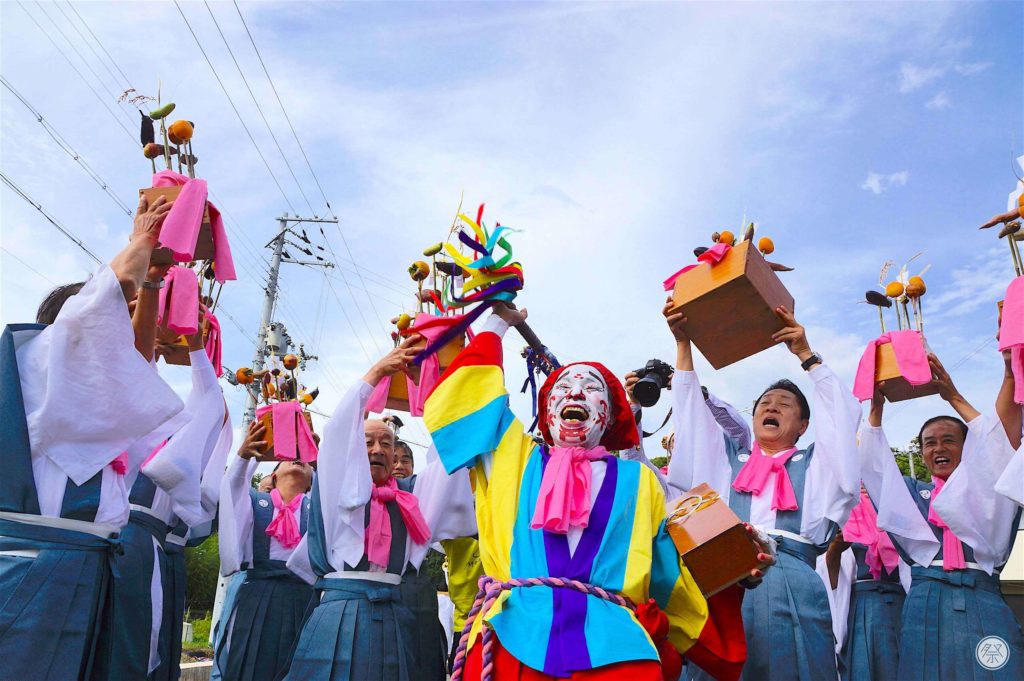
The story of this 200-year-old festival traces back to the legend about a goddess named Niutsuhime No Mikoto, whom other gods laughed at because she overslept and was late for a meeting.
The gods laughing at her made the goddess very sad, and she ended up locking herself up in Nyu Shrine; in an attempt to cheer her up, the villagers gathered around the Shrine and started laughing. Soon her sorrow disappeared, and she agreed to come out of the Shrine.
On the festival day, a parade starts with a bell ringer (Suzu Furi), who dresses as a clown with a bell and treasure box and leads the festival goers to a shrine. All while, the participants follow shouting “Warae, Warae,” meaning Laugh Laugh in Japanese. Once they all reach the Shrine, everyone laughs together.
Dates: Second Sunday of October
Location: Nyu Shrine in Hidakagawa, Wakayama Prefecture
5. The Kanamara Penis Festival (Kanamara Matsuri)
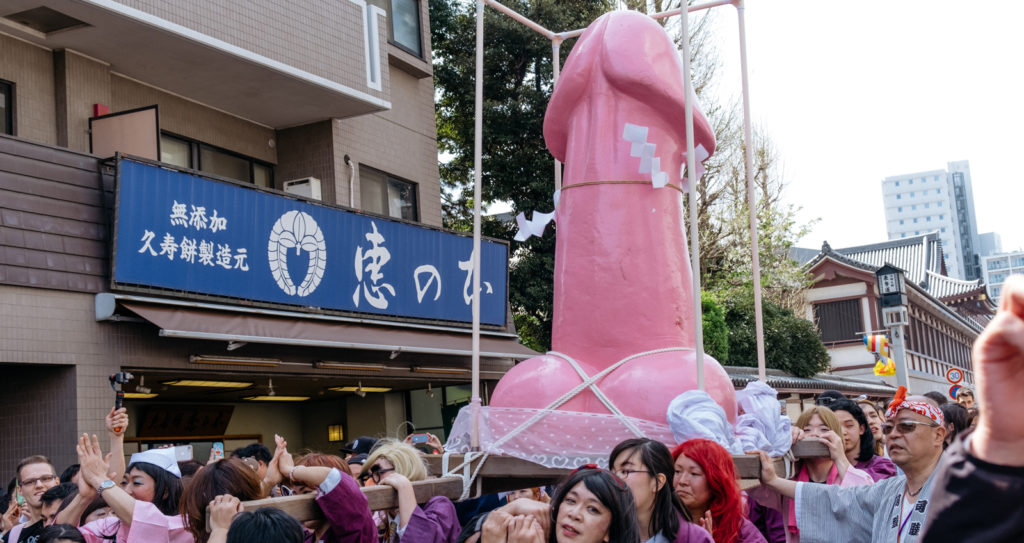
Of all the weird Japanese festivals, this one takes the proverbial cake. The Kanamara festivals, also known as the penis festival, dates back to the seventeenth century, but its celebration began only in 1969.
The bizarre tale behind the festival is about a sharp tooth demon in love with a beautiful woman; who disapproved of him, and that made him jealous of the men in her life. The demon hid inside her vagina and bit off all the penis of the men who she slept with.
Distressed, she went to a blacksmith who made her a steel penis (Steel Phallus). The steel penis broke the demon’s teeth, and the woman lived happily.
In honor of the steel dick, Kanamara Shrine was built, which people still frequent praying for good health, fertility, and happiness.
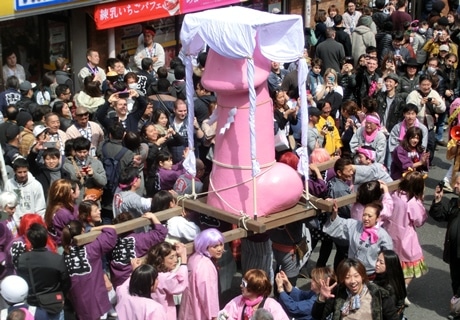
At the festival, festival-goers buy sucking penis shapes candies, ice creams and participate in all penis-themed activities.
The festivals the main highlight is the parade, which showcases three portable Shrines (Mikoshis):
- The Kanamara Fune Mikoshi: a mikoshi with a large steel penis,
- The Big Kanamara Mikoshi: a mikoshi featuring a large penis sculpture made of wood.
- The Elizabeth Float: a two-meter high pink penis given by the local drag queen club, carried by drag queens.

Photo courtesy travelbeginsat40.com
The festival celebrates people irrespective of their sexual preferences. Much of the LGBTQ crowd is drawn every year at the festival as it offers a chance to celebrate sex positivity, diversity, and inclusivity.
Dates: First Sunday in April
Location: Kawasaki, Kanagawa Prefecture
6. The Naked Festival (Hadaka Matsuri)
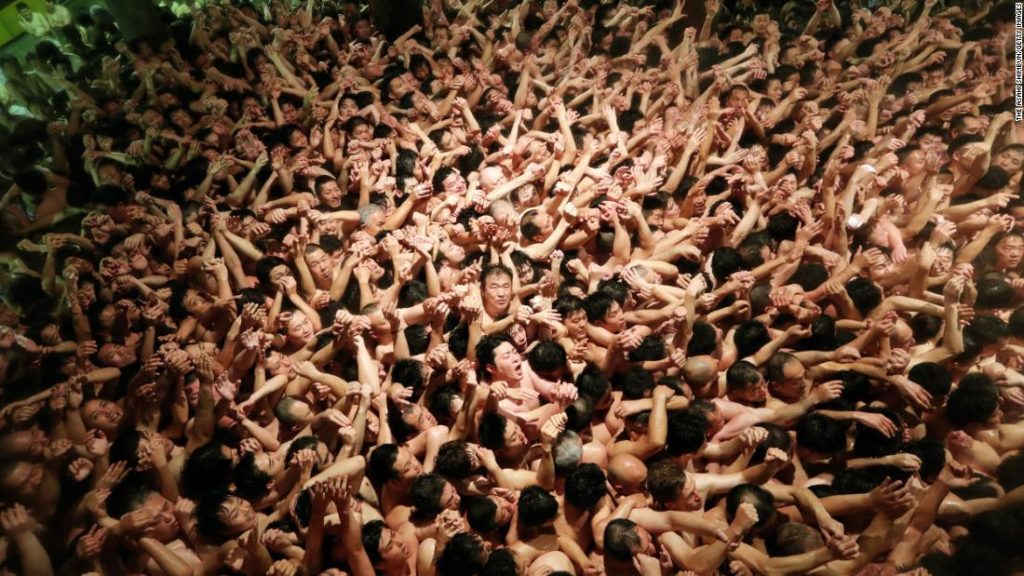
The locals believe the Hadaka Matsuri to be 500 years old; in this festival, around 10,000 men compete, wearing just a loincloth on a cold winter night.
On the festival day men first, take a dip in an icy cold pool as a part of the purification ceremony around the afternoon. At midnight, the lights of Sadai-Ji-Shrine are closed, and men clad in loincloth wrestle each other for lucky sticks thrown by the priests in below-freezing temperatures.
It is a belief that whoever gets these sacred lucky sticks is blessed with a
year of happiness.
Dates: 3rd Sunday in February
Location: Sadai-Ji-Shrine in Okayama
7. The Paantu Festival

This century-old festival is about scaring kids and covering everything on the way in mud; kids, adults, cars, and even homes.
The words Paantu stands for supernatural beings covered in mud and foliage. During the festival, many men and women playing Paantu cover themselves with mud and leaves with the faith that this would cleanse the island and drive out demons.
Another popular belief about the festival is that traumatizing kids as Paantu would help bring them good luck.
Dates: First two evenings in the first half of the ninth month of the Chinese calendar
Location: Miyakojima Island of Okinawa Prefecture
8. The Try Before You Die festival (Shukatsu Matsuri)

Fear of death might be an inevitable truth, and death, not something to be celebrated. But as the aging society in Japan comes to terms with accepting death, they commemorate it through a festival called Shukatsu, meaning preparing for one’s death.
People learn to say final goodbyes at this festival, wear funeral garments, plan whom to pass on their belongings to, and even lay down and try their coffin settlings.
Dates: September or December
Location: OTA City Industrial Plaza PIO, Tokyo (also other places in Japan)
9. The Bamboo Fight Festival (Rokugo no Kamakura Festival)
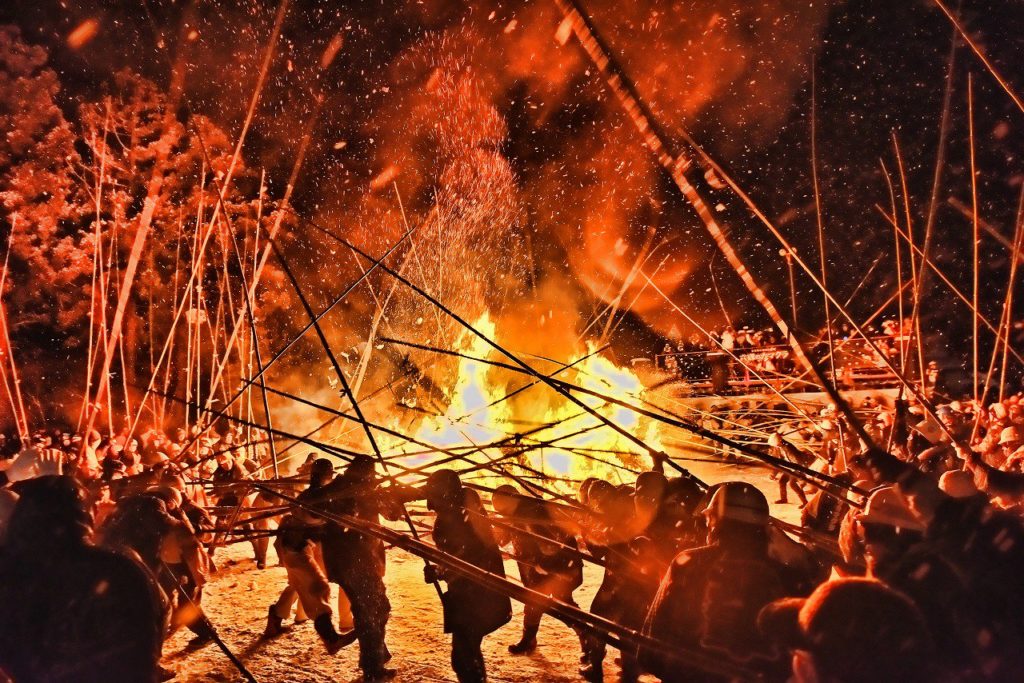
This is one of the older weird Japanese festivals, starting 700 years ago, taking place over five days.
The Bamboo Fight Festival comprises of three portions: the Toshigoi to pray for abundant harvests and safe prosperity, the Akumabarai to expel bad harvests and misfortune, and the Toshi-uranai to predict the year’s fortune.
One thousand green bamboos of about 7 meters in length are used for an intense bamboo fight between men representing the south and north. If the northern team wins there will be abundant harvests, and if the southern team wins, the price of rice will increase.
When the fight ends, they become the same townspeople. The men who finish the intense battle build a sacred fire with the broken bamboo while praying that the year will have abundant harvests.
Dates: 11th to 15 February
Location: In front of Suwa Shrine, Kamakura
10. The Mute Festival (Muon Bon Odori)

This festival is your solution if you are not a fan of loud noises. During this Bon Dance festival, FM transmitters make music available for all participants who receive earphones at the beginning of the dance. Making sure the dance goes on without any sound whatsoever.
Dates: August
Location: To-Kai city in Aichi Prafecture
There you have it, 10 weird Japanese festivals you must experience once travel to Japan becomes available. Be sure to bookmark this page for when you plan your next strange cultural voyage.
Have you been to any of these festivals? Let us know in the comments.




Amazing… Well written. Even though I am not a fan of reading It kept me engaged throughout… #KeepWritting